Speech The Changing Nature of Investment
Thank you for the invitation to speak at this year's AFR Business Summit. It is very good to be here.
The underlying question being asked at this summit is: how does Australian business prosper in today's changing world? This is an important question to be asking.
A strong and prosperous business sector is central to Australia's economic success. It is businesses – both small and large – that employ the bulk of Australians. It is businesses that have to compete globally and find new markets around the world for the goods and services that we produce here in Australia. And it is businesses that are responsible for most of the investment spending in the country. So it is in our collective interest to have a prosperous business sector.
This morning I would like to talk about the importance of investment in helping deliver that prosperity. It is through investment that firms develop new products, find better ways of doing things and expand their productive capacity. This means that the investment climate and the level and nature of investment have an important bearing on our future prosperity.
My remarks will be in three parts. First, I will focus on recent cyclical developments in non-mining investment, including the recent lift in investment. Second, I will discuss some structural changes in the nature of investment in the Australian economy, including the increasing importance of investment in technology and knowledge-based capital. I will finish with some remarks about the investment climate and the role the RBA can play.
Recent Trends
Over the past decade or so, the resources sector has been the dominant investment story in Australia. This investment has greatly expanded productive capacity in the resources sector, and this is flowing into increased exports. This story is well known so I will not go over it again today. Instead my focus is on non-mining investment.
During the mining investment boom it was understandable that investment in the rest of the economy was subdued. But as the boom unwound, the pick-up in non-mining business investment was slow to come. For a few years, a common theme in commentary from the RBA was that non-mining investment was weaker than we had been expecting. Indeed, for six or seven years the level of non-mining investment did not change very much (Graph 1). During this period, the RBA highlighted high hurdle rates of return and a lack of animal spirits. And the businesses we spoke with cited numerous uncertainties: uncertainty about the global economy, technology, politics and the level of household debt, among other things. For many firms, these uncertainties were a reason to delay investment spending; to wait for more clarity before proceeding.
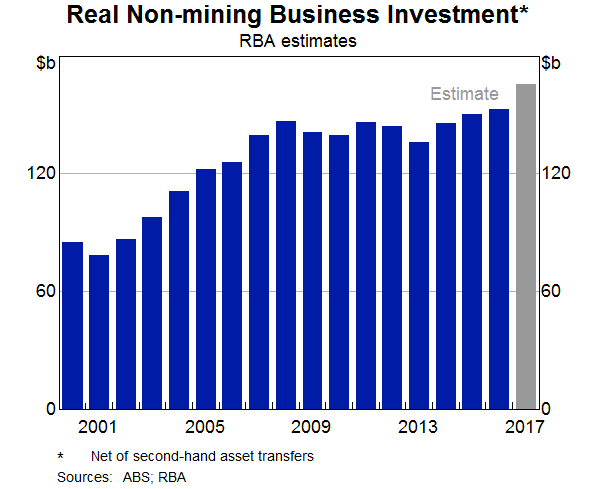
Over the past year the picture has begun to change. While we don't get the final investment figures for 2017 until later this morning, we estimate that over the past year, non-mining business investment increased by around 9 per cent. This is stronger than we were expecting a year ago and would be the largest increase since the onset of the global financial crisis. We expect to see further growth over this year. While businesses still face some significant uncertainties, including the future strength of consumer spending in a world of low real income growth and high household debt, the picture is a better one than it has been for some time.
The pick-up in investment reflects a combination of factors. One is the stronger global economy, which has boosted demand and reduced some of the uncertainties that businesses face. Another is the continuation of accommodative monetary policy in Australia; borrowing costs here remain low and finance is available. The ongoing growth in Australia's population has also played some role. Since 2008, Australia's population has increased by 3½ million people, or 16 per cent. This growth, combined with low levels of investment, has started to put pressure on capacity utilisation (Graph 2). It is also relevant that businesses are reporting stronger business conditions than at any time since before the financial crisis.
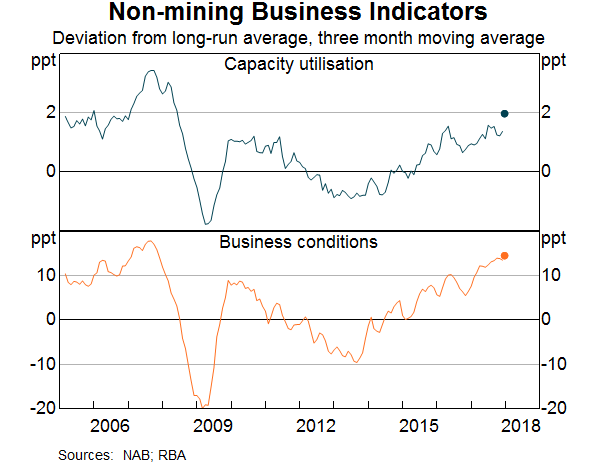
Another important part of the investment story recently is strong growth in investment in public infrastructure (Graph 3). The pick-up has been particularly noticeable in spending on transport infrastructure in the eastern states and the pipeline of work to be completed is large. The extra investment is directly creating demand in the economy today and adding to tomorrow's productive capacity. The Bank's analysis is that there are positive spillovers to the rest of the economy from the spending on public infrastructure, especially given that we still have some spare capacity.[1] In our business liaison, a number of firms report that they are investing more to meet the extra demand from infrastructure projects. So it is a positive story.
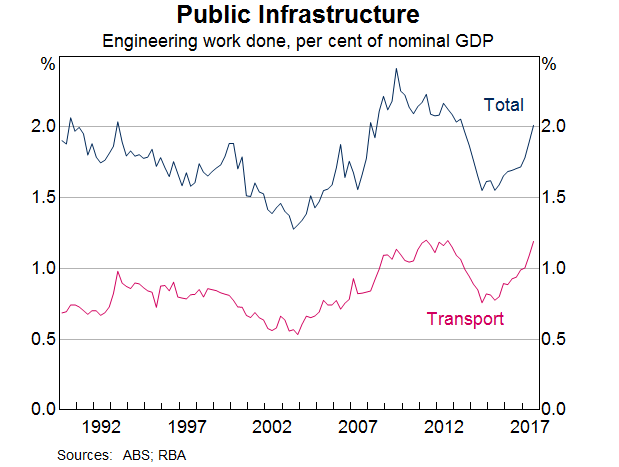
Changing Nature of Investment
I would now like to take a more structural perspective and highlight two changes in the structure and nature of investment. The first is the increasingly important role played by investment in information technology. And the second is a change in the industries in which investment is occurring.
Over recent times, one of the central themes in the RBA's discussions with businesses has been the much greater use of information technology to increase productivity. Among other things, we hear about the possibilities and the challenges of data analytics, machine learning, artificial intelligence, the better use of sensors to control production and the automation of processes and production methods.
A similar picture emerges from a survey undertaken by Ai Group last year, where CEOs were asked about their main investment priority for the year ahead. At the top of the list were investment in technology and the staff training that is needed to support that investment (Graph 4). Next on the list was investment in research and development (R&D). Further down the list was investment in physical assets. If we look back at previous surveys, it's clear that this focus on investing in technology has increased over time.
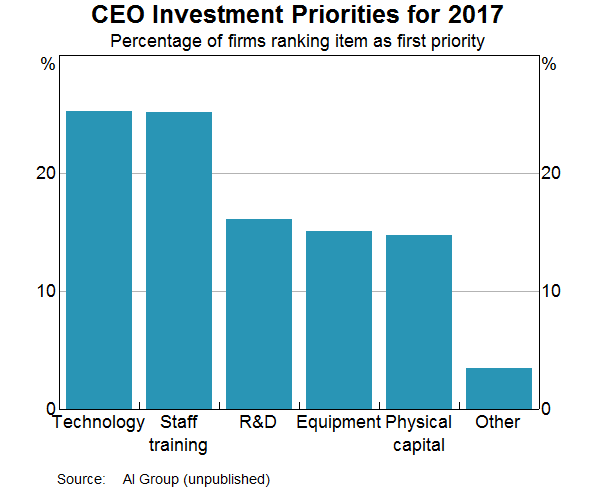
This is not to underplay the importance of investment in physical assets. This remains critical. We need places to work, live, shop and play, and investment in buildings & structures and machinery & equipment remains central to this. But increasingly, investment decisions in these areas are also often just as much about technology as they are about other things. In every industry – in manufacturing, mining, agriculture, the health sector and business services – businesses are having to make investments in information technology to remain competitive. This is changing the way we think about investment.
Tracking this shift in investment for the economy as a whole is complicated by some limitations in the available data. The ABS does, however, publish separate figures for investment in buildings & structures, machinery & equipment and intellectual property (Graph 5).[2]
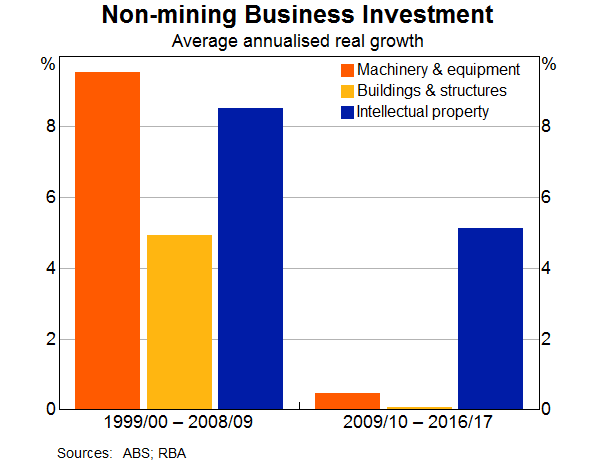
These data show that over the past couple of decades, investment in intellectual property has grown noticeably faster and more consistently than investment in buildings & structures and machinery & equipment. This is particularly so since 2009/10. Over this period, the weakness in overall non-mining investment is explained by there being almost no growth in investment in tangible assets. In contrast, investment in intellectual property has grown at an average rate of 5 per cent.
Following this sustained period of strong growth in investment in intellectual property, this component now accounts for around 20 per cent of total non-mining investment, in nominal terms. By way of comparison, this share was just 3 per cent in the early 1980s (Graph 6). Conversely, the share of investment spending on machinery & equipment has declined over time. This is partly, but not wholly, explained by the steady decline in the relative price of machinery & equipment.
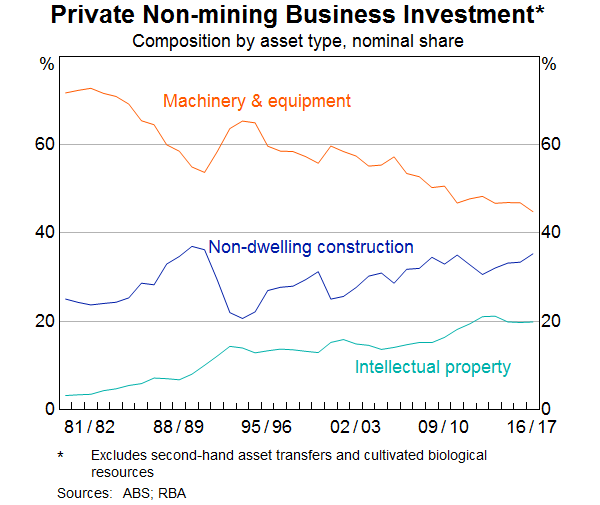
These shifts are significant and are consistent with the rising importance of investment in information technology. Within the broad heading of intellectual property, we can further disaggregate the data into investment in computer software, R&D and artistic originals (Graph 7). Over recent times, the strongest growth has been in investment in software, with investment in this area doubling over the past seven years. The picture for R&D is a little different; investment in R&D has not grown for a few years now, but this follows earlier strong growth.
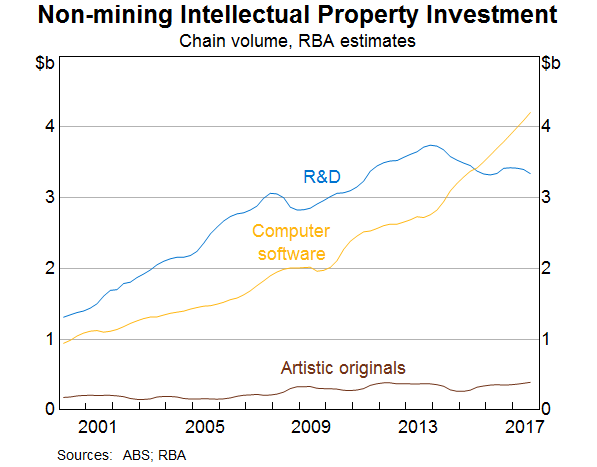
The impact of the increased investment in technology is also evident in the figures for output growth by industry. In particular, since the early 1990s, the fastest growing industries in the Australian economy have been information, media & telecommunications and professional, scientific & technical services. Both have grown faster than the mining industry, recording compounded average growth of around 5 per cent per year. The effects are also evident in the labour market, with strong demand for various types of workers in information technology. Indeed, some of the pockets of the Australian labour market in which wage growth has picked up over recent times are in professional, scientific & technical roles.
The second structural change that I want to highlight is a shift in the industries in which investment is taking place.
This shift can be seen in this next graph, which shows the share of non-mining investment accounted for by various industries (Graph 8). In the 1980s, the manufacturing industry accounted for around one quarter of non-mining investment in Australia. At that time, manufacturing required high levels of investment in machinery & equipment, not only to expand capacity, but to offset fairly high rates of depreciation. So investment in the manufacturing industry accounted for a large share of total investment. But since the mid 1990s, manufacturing has accounted for a steadily declining share of non-mining investment. Today, that share stands at just 11 per cent. In contrast, the shares of investment accounted for by information, media & telecommunications and professional, scientific & technical services have increased significantly. Combined, these two industries now account for about 16 per cent of non-mining investment, up from around 8 per cent in the early 1990s. Investment in health, education and transport has also increased as a share of total investment.
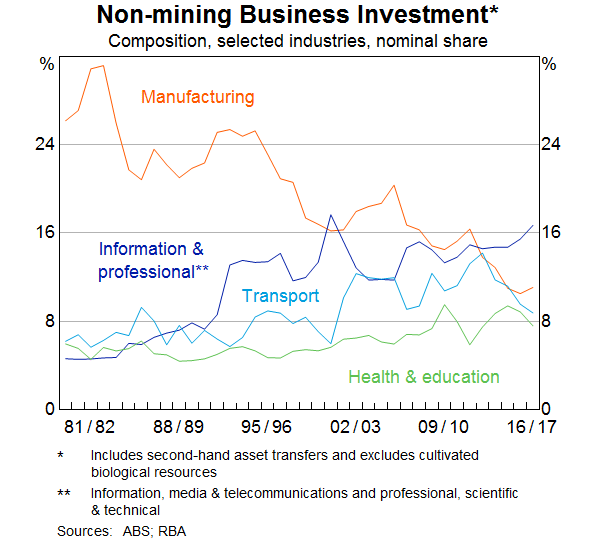
Given these structural changes, one question that sometimes gets asked is: do we need less investment than we used to? This question has also been raised in the context of the subdued levels of non-mining investment over recent years: perhaps we simply don't need to devote the same share of output to investment as we once did?
There isn't a straightforward answer to this question, but our analysis points to a couple of conclusions.
The first is that the increased emphasis on technology and the shift to an increasingly service-oriented economy explains some – but only some – of the subdued levels of investment spending over recent years. Rather, the bulk of the explanation for low levels of investment lies in what has been going on within individual industries, not shifts across industries. In most industries, the ratio of investment spending to output has been relatively low over recent years (Graph 9).
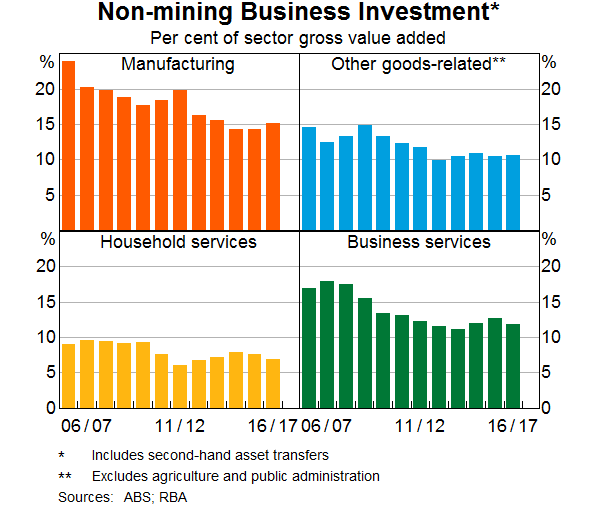
The second conclusion is that, from a longer-term perspective, it is plausible that non-mining investment will account for a lower share of GDP than used to be the case. This largely reflects the decline in manufacturing as a share of the economy and the fact that the ratio of investment to output in the manufacturing industry is higher than in most other industries. While putting precise numbers on the size of any change is difficult, we estimate that this shift away from manufacturing could reduce the steady-state ratio of non-mining business investment to GDP by 1 to 2 percentage points.
It is important, though, to point out that this does not mean the ratio of total investment to GDP will necessarily decline by this amount. This is because of what has happened in the resources sector, where there has been a very large increase in the capital stock. This higher capital stock means more depreciation, and more depreciation requires more investment to maintain the higher capital stock. So it is likely that the amount of investment in the resources sector, as a share of GDP, will be higher than it was before the mining investment boom. We are already seeing some evidence of this, with increased spending on ‘sustaining’ the capital stock being one of the factors behind the recent improvement in the Western Australian economy.
The main point of all these facts and figures is that the nature of investment in the Australian economy is changing. There is a much greater focus on information technology and a shift to investment in the service industries. This has implications for how we think about investment and the measures necessary to create an environment that supports investment in our modern economy.
The Investment Climate
This brings me to the third issue I raised at the outset: that is the importance of a positive investment climate.
No matter what type of investment a firm is considering, the environment in which the decision is being made has a major bearing on the decision to invest or not.
Australia's long record of economic and financial stability is a positive from this perspective. So, too, are our strong legal system and our well-established institutions. To this list I could add the opportunities offered by our links to the fastest-growing part of the global economy and our skilled, diverse and flexible workforce. All these things make Australia an attractive place to invest.
But we can't rest on these advantages. It is a competitive world out there and the nature of comparative advantage is changing. Once upon a time, comparative advantage came largely from a country's endowments or resources. Indeed, in our own case, the big waves of investment in Australia have been to capitalise on our natural endowments. These resources have made us wealthy and they are central to our continued prosperity. But in today's world, comparative advantage is just as likely to be built, as it is to come from endowments. It is likely to be built through innovation, creativity and ingenuity. And it is likely to be built through investing in information technology and the skills of our labour force.
Creating a positive environment that encourages this investment is a joint responsibility of government and private business. The government certainly has an important role to play, but so does business. A business culture that highly values innovation and competition and that is not afraid of taking risk will surely help in creating this positive environment.
There are no simple answers here. But a recent report by Innovation and Science Australia provides some guideposts. The report's subtitle is ‘A plan for Australia to thrive in the global innovation race’. It is worth a read. The report rightly focuses on the importance of education and the accumulation of human capital. Our ability to innovate rests on the skills of our workforce, so investing in these skills is central to building a positive investment climate. The report also discusses the way we go about research and development and how we can support innovative firms. It also discusses the importance of culture and ambition.
Over recent times there has also been quite a lot of discussion about the effect of tax on the investment climate and international competitiveness. This is an important discussion to have as Australia does need to remain an attractive place for global capital to invest. As we have this discussion, it is also important that we keep focused on the other issues I just touched on, as these areas play an important role in building durable comparative advantage and prosperity.
I would like to finish with a few words about the role of the RBA in contributing to a positive investment climate.
We obviously have no role in influencing the structural considerations that I just spoke about. We do, though, have an influence on the overall environment within which business investment decisions are made.
At the highest level we seek to be a source of stability and confidence. Having strong credible institutions in the country helps provide the community with a degree of confidence. We seek to build and maintain this credibility through developing a reputation for being a central bank that is transparent, independent, pragmatic and analytical.
Beyond this contribution, the investment climate is obviously better if we are able to deliver on our core goals of monetary and financial stability. Investors should have confidence that, over time, CPI inflation in Australia will average between 2 and 3 per cent. They can expect some variation from year to year, but over the medium term the average inflation rate will be 2 point something. As I have spoken about on previous occasions, we pursue that objective in a way that promotes sustainable growth in the economy and pays close attention to financial stability risks.
You may have noticed that at yesterday's meeting, the Reserve Bank Board left the cash rate unchanged at 1½ per cent, where it has been since August 2016.
Our assessment is that the economy is moving in the right direction. We expect stronger growth in 2018 than in 2017 and a further reduction in the unemployment rate. We also expect inflation to increase a little from its current low rate. These developments should help support the climate for business investment.
With the economy moving in the right direction, and interest rates still quite low, it is likely that the next move in interest rates in Australia will be up, not down. Having said that, the expected progress in reducing unemployment and having inflation return to target is likely to be only gradual. With only gradual progress expected, the Board does not see a strong case for a near-term adjustment of monetary policy. We will, of course, keep that judgement under review at future meetings.
Thank you for listening. I am happy to answer questions.
Endnotes
I would like to thank Andrea Brischetto, Mark Chambers and Michelle van der Merwe for assistance in the preparation of this talk. [*]
See Reserve Bank of Australia Statement on Monetary Policy ‘Box C: Spillovers from Public Investment’, February 2018. [1]
Data on investment in cultivated biological resources – that is farmed livestock, orchards and the like – are also published. These are excluded from the figures reported in this section. Investment in cultivated biological resources has declined from over 40 per cent to just below 4 per cent as a share of overall non-mining investment over the past six decades as livestock farming has become a smaller part of the economy. [2]
